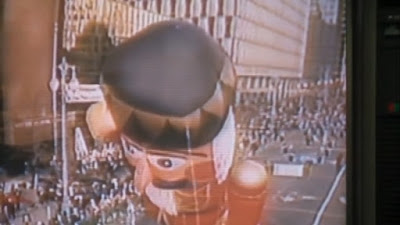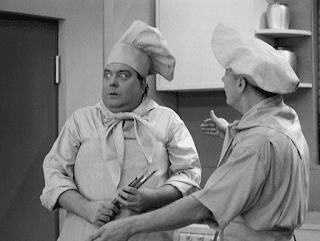But for everyone else, it was highly sought after because most of the places we stayed in were some run down off-brand motel like the Presque Isle Inn (Presque Isle, Maine) Martha's Vineyard Campground (CAMPGROUND!) or the Beckley Motor Inn (Beckley, WV.) By the way, Presque Isle is not an island. It's as far north in Maine as you can go, and you can drive south and still hit Canada.
In Plattsburgh, however, we stayed in a brand new Hampton Inn on the main drag. There was an Applebees, a few sports bars, some shopping... and directly next door was a Ponderosa buffet.
I mean, who doesn't love a buffet?
The Captain I flew with frequently at the time, Matt, would always say "See you in 5 minutes" during check-in, and that would be code for I'll be at the Ponderosa as soon as I can take off my uniform and run across the parking lot.
So here for the latest installment of "Retro Restaurants," we'll take a deeper dive into The Ponderosa and Bonanza Steakhouse buffets! You can't tell The Ponderosa Steakhouse story, however, without mentioning it's sister, The Bonanza Steakhouse. The two restaurants started separately with similar themes and menus but eventually became one and the same.
The Ponderosa and Bonanza Steakhouse, both currently owned by FAT Brands Restaurants, are a chain of buffet and steakhouse restaurants. Menus include steak, seafood, and chicken entrees, all of which come with a buffet-style spread of numerous side dishes, kid's food items, beverages, and desserts.
The two restaurants began life separately but were both created with the classic TV series "Bonanza" in mind. On the show, the action took place at the "Ponderosa Ranch," hence the restaurant branding. Unlike other chains with multiple marketing brands who only use one specific name in a given region, like Checkers/Rallys or White Castle/Crystal's, The Ponderosa and Bonanza are located in similar areas due to their separate origins.
How did it all begin, you ask?
After four years of playing "Hoss" on Bonanza, Dan Blocker created the first Bonanza Steakhouse (then called Bonanza Steak Pit) in Westport, Connecticut, in early 1963. Westport, Connecticut, for any of you who may be interested, was the town that The Ricardos moved to in the final season of I Love Lucy. (Lucy reference number 4,317 here at YRM.)
Through good food and Blocker's fame, the chain began to proliferate. After three years, brothers Sam and Charles Wyly, purchased the restaurant chain from the actor, who agreed to continue to make public relations appearances. The two brothers steadily grew the company to a peak of 600 locations in 1989 when they eventually sold the business.
Meanwhile, in 1965, over in Kokomo, Indiana, Norm Weise and Dan Lasater opened the first Ponderosa Steakhouse. Dan Lasater was barely in his 20s when he started the chain with a fresh high school diploma and a few years of experience managing a McDonald's restaurant. Norm Weise had no restaurant experience as a life long car salesman. He did, however, own a crucial piece of real estate along a highway in Indiana that was well suited for their first location... of a fast-food hamburger restaurant named Scotty's.
The folks over at The Bonanza didn't take kindly to the creation of a restaurant with a similar menu and same western theme based on the same TV show. In a humorous story, Bonanza management, in an effort to stop The Ponderosa from growing, went out and trademarked The Ponderosa Restaurant name. Except, in their rush, they had forgotten to trademark their own name, which Dan Lasater of The Ponderosa immediately trademarked. Eventually, the two businesses agreed to swap trademarks and live and let live.
 Jack Roshman had been the largest franchisee of fast-food chain Burger Chef when he joined in at the early stages of The Ponderosa. He took the chain into Ohio while Lasater and Wiese expanded west into Illinois. Rapid expansion and multiplying sales eventually caused financial ruin for the company through unchecked management and failing supply chains.
Jack Roshman had been the largest franchisee of fast-food chain Burger Chef when he joined in at the early stages of The Ponderosa. He took the chain into Ohio while Lasater and Wiese expanded west into Illinois. Rapid expansion and multiplying sales eventually caused financial ruin for the company through unchecked management and failing supply chains.The Ponderosa turned to Gerald S. Office, Jr., a 28-year-old attorney. Promoting him from general counsel to chairman and CEO, he turned The Ponderosa around, and by 1971 they recovered enough to warrant a new stock offering. Stock in Ponderosa soared from $3 per share in 1970 to $84 a share in 1972 when it surpassed Bonanza to become the nation's largest steak chain.
Lasater decided to retire at that point, a 30-year-old multimillionaire set for life.
The Ponderosa chain began expanding operations in Canada in 1971 until 1986 when it moved its focus back to the US during the Ronald Reagan era boom years. In doing so, 36 Canadian Ponderosa locations were acquired by the General Mills Restaraunt Group. General Mills immediately converted them to Red Lobster restaurants. Bonanza, on the other hand, continued to operate its locations in Canada.
By the mid-80s, however, the chain was beginning to face problems once again. Failing to change with the public interest in healthier foods such as chicken and fish, the menus seemed dated, and the establishments became old and worn. In 1985, a year after fighting off a takeover from Hickory Farms, Ponderosa faced another takeover attempt by third-ranking Bonanza. While the offer of $154.8 million was ten percent over the Ponderosa's stock price, the board of directors rejected the offer. The legal defense was costly, but the company managed to fend off all competitors.
In 1988, Metromedia purchased the Ponderosa chain. Metromedia then scooped up competitor S & A Restaurants, which operated the "Steak and Ale" brand of steakhouses and the "Bennigans" family restaurant chain.
 A year later, they purchased The Bonanza in what seemed like the dynamic duo of low-cost steakhouse empires. While they had similar themes and objectives, the two companies couldn't be more different from a corporate standpoint. Ponderosa was mostly company-owned buildings concentrated in the Midwestern United States while the Bonanza was nearly an entirely franchise owned business mainly in the South and Southwest. As a matter of fact, the company itself only owned two locations in its entire network.
A year later, they purchased The Bonanza in what seemed like the dynamic duo of low-cost steakhouse empires. While they had similar themes and objectives, the two companies couldn't be more different from a corporate standpoint. Ponderosa was mostly company-owned buildings concentrated in the Midwestern United States while the Bonanza was nearly an entirely franchise owned business mainly in the South and Southwest. As a matter of fact, the company itself only owned two locations in its entire network.Bonanza franchisees feared that the acquiring company, Ponderosa (through Metromedia), would phase out their Bonanza name and took legal action. Several incorporated into a large franchise association, and others brought lawsuits. After much legal wrangling, several major Bonanza owners eventually converted to the Ponderosa brand. It was not made mandatory by Metromedia to change... it was just "highly suggested."
The profitability of each chain was based on the fluctuating price of American beef and a very price-conscious customer base. When the United States dipped into a recession in the early 1990s, business went into a steep decline. The Ponderosa had more locations than any other American steakhouse chain, but management shakeups and declining profits saw sales fall behind revenue leading restaurant The Sizzler by over $100 million.
The two chains struggled along through the post 9-11 recession, but in 2008, when the economy tanked, Metromedia Family Steakhouses Company filed for Chapter 11 bankruptcy. Plans were made to reorganize around new franchises and a profitable core of its self-owned restaurants. It emerged from bankruptcy protection in 2009 under a new name of "Homestyle Dining, LLC."
 In 2017 the Restaraunt was sold to FAT Brands, who owns "Fatburger," "Buffalo's Cafe," and "Hurricane Grill and Wings." Hurricane Grill and Wings has over 300 restaurants open with 300 in development and hope for the future of Bonanza and Ponderosa is bright, although, with 2020 Coronavirus... buffets may not fare so well.
In 2017 the Restaraunt was sold to FAT Brands, who owns "Fatburger," "Buffalo's Cafe," and "Hurricane Grill and Wings." Hurricane Grill and Wings has over 300 restaurants open with 300 in development and hope for the future of Bonanza and Ponderosa is bright, although, with 2020 Coronavirus... buffets may not fare so well.Today, there are about 75 of them, including a handful in Qatar and the UAE. It's still a big hit on the Persian Gulf, apparently, not to mention in Puerto Rico.
In my personal experience, if you've ever been to a Golden Corral, then you've been to a modern Ponderosa. Gone are the western motifs and television show references. You'll find walking in soothing, solid colors and bland signage.
Unfortunately, in 2020, with the coronavirus lockdowns killing the booming American economy, local governments continued shutdown of eat-in restaurants, and the general public's reluctance to readily eat at a buffet, you may want to stop in at The Ponderosa or The Bonanza before it's too late.
If you can still find one.









.png)




Comments